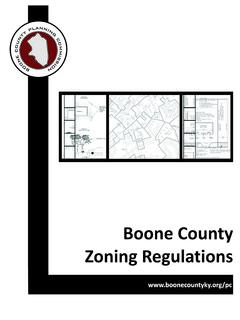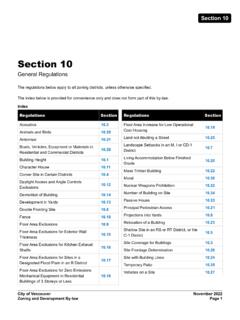Transcription of Land Use Planning for Large-Scale Solar
1 SolSmartLand Use Planning for Large-Scale SolarMegan DayNational Renewable Energy LaboratorySeptember 27, 2018 NREL/PR-7A40-72470 NREL is a national laboratory of the Department of Energy, Office of Energy Efficiency and Renewable Energy, operated by the Alliance for Sustainable Energy, LLC. This work was authored by Alliance for Sustainable Energy, LLC, the Manager and Operator of the National Renewable Energy Laboratory for the Department of Energy (DOE) under a subcontract to The Solar Foundation for the SolSmart program. Funding for SolSmart is provided by the Department of Energy Office of Energy Efficiency and Renewable Energy Solar Energy Technologies Office. The views expressed herein do not necessarily represent the views of the DOE or the Government. The Government retains and the publisher, by accepting the article for publication, acknowledges that the Government retains a nonexclusive, paid-up, irrevocable, worldwide license to publish or reproduce the published form of this work, or allow others to do so, for Government data, results, conclusions, and interpretations presented in this document have not been reviewed by technical experts outside NREL or the Solar Energy Technologies DOCUMENT WAS PREPARED AS AN ACCOUNT OF WORK SPONSORED BY ANAGENCY OF THE UNITED STATES GOVERNMENT.
2 NEITHER THE UNITED STATES GOVERNMENT NOR ANY AGENCY THEREOF, NOR ANY OF THEIR EMPLOYEES, MAKES ANY WARRANTY, EXPRESS OR IMPLIED, OR ASSUMES ANY LEGAL LIABILITY OR RESPONSIBILITY FOR THE ACCURACY, COMPLETENESS, OR USEFULNESS OF ANY INFORMATION, APPARATUS, PRODUCT, OR PROCESS DISCLOSED, OR REPRESENTS THAT ITS USE WOULD NOT INFRINGE PRIVATELY OWNED RIGHTS. REFERENCE HEREIN TO ANY SPECIFIC COMMERCIAL PRODUCT, PROCESS, OR SERVICE BY TRADE NAME, TRADEMARK, MANUFACTURER, OR OTHERWISE DOES NOT NECESSARILY CONSTITUTE OR IMPLY ITS ENDORSEMENT, RECOMMENDATION, OR FAVORING BY THE UNITEDSTATES GOVERNMENT OR ANY AGENCY THEREOF. THE VIEWS AND OPINIONS OF AUTHORS EXPRESSED HEREIN DO NOT NECESSARILY STATE OR REFLECT THOSE OF THE UNITED STATES GOVERNMENT OR ANY AGENCY is Large-Scale PV?Jacksonville Solar 15 MW Jacksonville, FLPhoto: juwi Americas Photovoltaic converts sunlight into electricity though semiconductor materials, not concentrating Solar power More than an acre 5-7 acres needed per Megawatt (MW) Often a commercial facility that is not net-metered or serving a particular buildingPhoto: Prairie Restorations, Plan for Large-Scale PV?
3 Under the Department of Energy s SunShot, low battery storage cost scenario, PV deployment is predicted to grow to an estimated 1,618 GW by 2050, requiring an estimated million acres of land , roughly equivalent to the size of Cited Large-Scale PV BenefitsPV array at the National Wind Technology Center Photo by Dennis Schroeder, NREL 11249490 Economic development (jobs & spending) Increased local property tax income without additional services Improves energy security distributed assets, no fuel needs Local power generation no shipping or purchasing of fuels Reduces environmental risk of fossil fuels mining, coal ash, greenhouse gases, mercury, PV Potential ImpactsPotential conflicts with other resources or development goals: Agricultural practices Loss of prime agricultural soils Loss of local productive capacity Fragmentation of land Forested areas Historic resources Redevelopment and density Natural areas Habitat Aesthetics/viewshedsWyandot County Airport, OH Photo credit.
4 Juwi AmericasLarge- scale PV Concerns Less reflective than water and windows and compatible with nearby residential, office, or aviation usesNo glare 45 decibels at 10 meters from the inverters, which is slightly less noise than a refrigerator makesVery low noise Photovoltaicmodulesareenclosed in glass, carry a 25 yearwarranty, meetall applicableelectricaland safetystandardsSafe Far lower voltage than transmission lines No electro magnetic field (EMF) impactsLow Solar in zoning CodesSolar Energy device or structural design feature, a substantial purpose of which is to provide daylight for interior lighting or provide for the collection, storage, and distribution of Solar energy for space heating or cooling, electricity generation, or water Energy System, Large-Scale : Active Solar Energy System that occupies more than 40,000 square feet of surface area.
5 Solar Energy System, Medium- scale : Active Solar Energy System that occupies more than 1,750 but less than 40,000 square feet of surface area. Solar Energy System, Small- scale : An Active Solar Energy System that occupies 1,750 square feet of surface area or distinguish between rooftop and credit: Farms Industrial land UseIndustrial zoning and land use characteristics Access to major transportation corridors, water, sewer = EXPENSIVE Often urban, smaller parcels = EXPENSIVE, too small Employment Nuisances (noise, traffic, pollution)Tonopah/Arlington Area Plan definition INDUSTRIAL: major employment centers, Uses permitted in this category include warehousing, storage, distribution activities, and manufacturingRequiring change of land use/ zoning for Solar amountsto spot zoning and stranded industrial zoned land PV should not be restricted to Public Utilities zoning PV farms traditional power plants.
6 Do not need: Massive amounts of water for cooling On-site personnel Fuel delivery via rail, road, or pipelineWith appropriate development guidance, Large-Scale PV facilities can provide:Water quality protection Perennial ground cover that reduces runoff, soil conservation, vegetated wetland and waterway buffersHabitat value Pollinators, small mammals, birds, reptilesAgricultural opportunities Apiaries, grazing, high-value hand-picked crops, pollinator benefits for nearby cropsVegetation benefits to PVIncreased PV efficiencies Lowers temperatures beneath panelsReduced O&M costs With low height vegetation and/or grazingPhoto credit: Prairie RestorationsLow-Impact Solar DevelopmentNREL s National Wind Technology Center s Solar installation where native grasses and revegetation techniques were Minimizing grading Minimizing soil compaction Planting native vegetationPotential Ag Benefits of PV Pollinator HabitatExamining the Potential for Agricultural Benefits from Pollinator Habitat at Solar Facilities in the United StatesLeroy J.
7 Walston,Shruti K. Mishra,Heidi M. Hartmann, Ihor Hlohowskyj, James McCall, and Jordan MacknickEnvironmental Science & Technology, the Economic Value of Pollination to Improve Adoption of Solar Facilities in Agricultural Environments, NREL and Argonne National Laboratory, 2018, publication pendingAn NREL and Argonne National Laboratory InSPIRE study identified over 3,500 km2(800,000 acres) of agricultural land near existing and planned Large-Scale PV facilities that may benefit from insect pollinators. If 10% to 50% of existing and planned Solar facilities were used for pollinator habitat, they would produce $ to $ billion in pollination benefit annually. Pollinator Friendly/Ag Preservation PoliciesPhoto: Prairie Restorations, PolicyMinnesotastandards for pollinator-friendly Solar legislation Statute of Natural Resources Solar Generation Facilities Pollinator Friendly DesignationSouth Carolina Solar Habitat Act Voluntary Solar best-management practices to establish native vegetation and pollinator habitatOregonLand Conservation and Development regulations aim to limit Large-Scale Solar development on high-value farmland and arable land and address soil compaction, erosion, and noxious PolicyLinn County, IA Amended the Development Code to require Solar farms be planted with native grasses and wildflowers and prohibits application of County.
8 MN land Use and zoning Ordinance requires Solar farm ground cover meet above state farms provide opportunities for honey Farms and ApiariesMilwaukee Journal Sentinel, 2011 Midwest Energy News: the-farm-back-in - Solar -farms-study-to -test-crop-potential-at -pv- grazing is an increasingly common vegetation management on NREL s InSPIRE project: Co-locating Agriculture and Solar Farms and AgriculturePlanning for Large-Scale PV --SummaryPV array at the National Wind Technology Center Photo by Dennis Schroeder, NREL 11249490 Comprehensive planRecognize your Solar resourceEstablish Solar goals and objectivesZoning for Large-Scale PVDifferentiate between rooftop and ground mountedDifferentiate between small-and Large-Scale PVEstablish development standards that achieve Solar goals and objectivesOptions for attracting beneficial Solar developmentOffer expedited permitting review if projects meet established development standardsBase permitting fees on plan review time and expense rather than a percentage of construction costsOffer property tax or sales tax exemptions or reductionsProvide clarity from County Assessor on how development will be taxedConsider ground cover standards and PV and agriculture co-benefitsSolSmart To make it faster, easier, and more affordablefor more Americans to choose Solar energy.
9 SolSmart will recognize at least 300 local governments with a nationally prestigious Solar Earn Bronze, Silver, or Gold designation based on Solar -related actions. Demonstrate that the community is open for Solar business, making it more attractive to Solar Communities can receive no-cost technical assistance on: Siting permitting Inspection Planning and zoning















